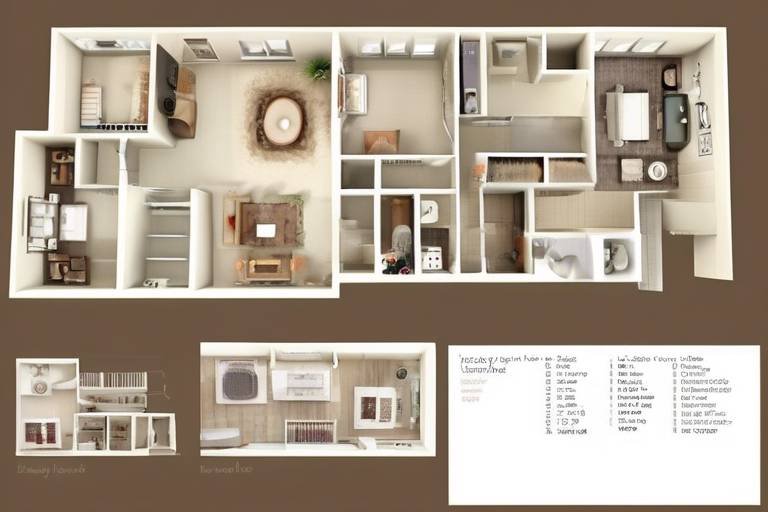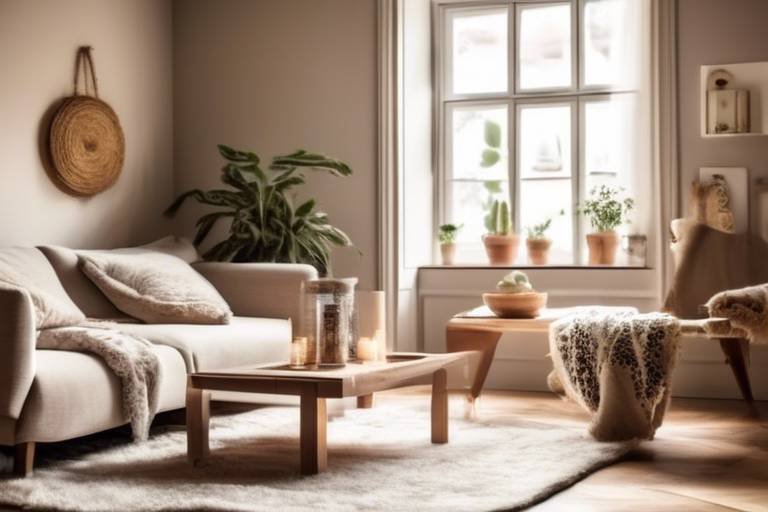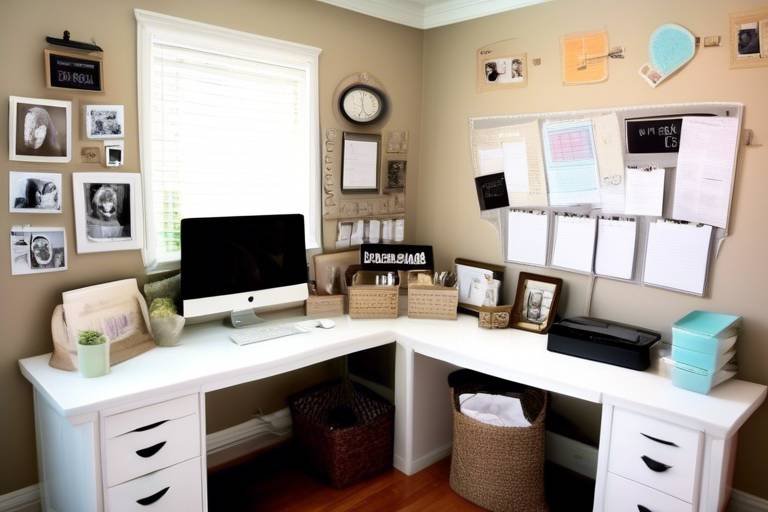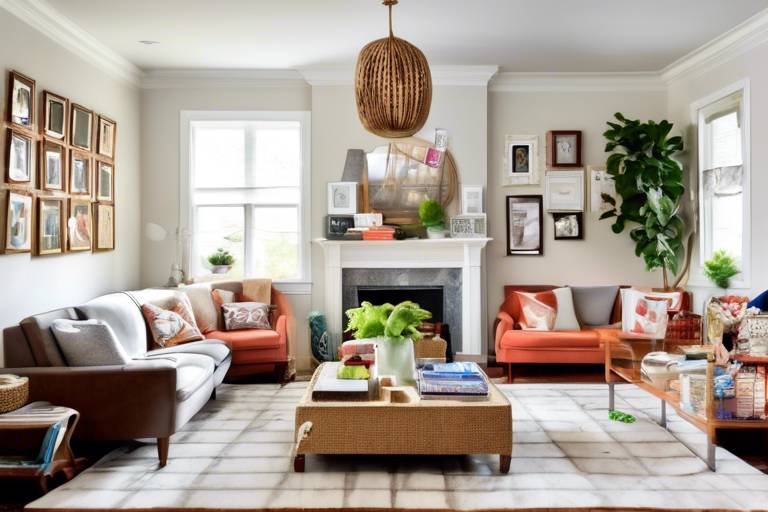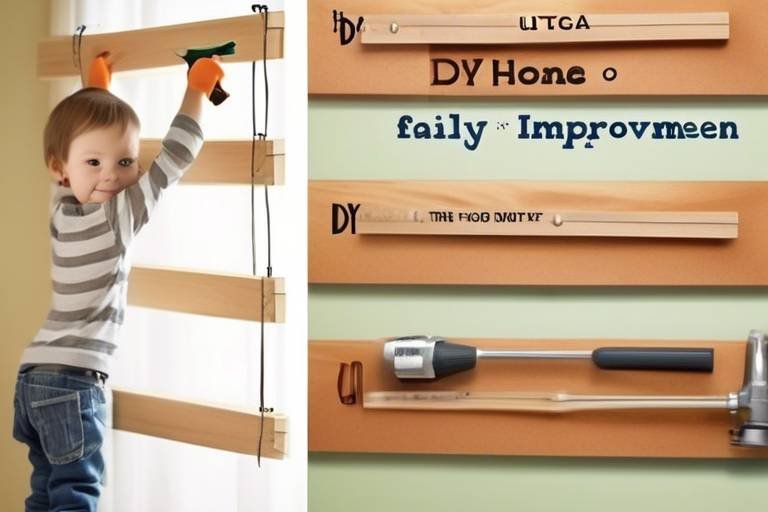Finding the Ideal Home Layout for Your Family
Choosing the right home layout is not just about aesthetics; it's about creating a space that feels like a haven for your family. Imagine walking through your front door and feeling an immediate sense of comfort and belonging. That's the magic of a well-thought-out home design! But how do you find that perfect layout that caters to everyone’s needs? It all starts with understanding your family's unique dynamics and lifestyle. Whether you have energetic kids, a home office setup, or love hosting friends and family, your home should reflect and support those aspects of your life.
First things first, let’s talk about the importance of understanding family needs. Before you even start looking at houses or drawing up plans, take a moment to sit down and think about what your family truly requires. How many people will be living in the home? What are their ages and interests? For instance, if you have teenagers who need their own space, or younger kids who require a safe play area, these factors will heavily influence your choice of layout. Don't underestimate the power of a simple list to outline your family's must-haves:
- Number of bedrooms
- Common areas for socializing
- Quiet spaces for studying or working
- Outdoor access for play and relaxation
Once you have a clear picture of your family's needs, you can dive into the next crucial decision: open vs. closed floor plans. This is where things can get really exciting! Open floor plans are all the rage right now, and for good reason. They create a sense of spaciousness and encourage interaction. Picture this: your kids are playing in the living room while you’re cooking dinner in the kitchen. You can easily keep an eye on them, and they can feel included in the family activities. But, let’s not forget about the benefits of closed floor plans. They offer distinct spaces that can provide the privacy some family members crave, especially if you have a mix of introverted and extroverted personalities in your household.
Now, let’s explore the benefits of open floor plans. One of the standout features is the enhanced natural light. With fewer walls, sunlight can flood into your home, creating a warm and inviting atmosphere. This can significantly improve your mood and energy levels. Additionally, open layouts offer flexibility in design. You can rearrange furniture, add decor, and even change the purpose of a space as your family grows and evolves. It’s like having a blank canvas that adapts to your lifestyle!
On the flip side, closed floor plans have their own set of advantages. They provide distinct, private spaces for family members. If someone needs to focus on work or study, they can retreat to a quiet room without distractions. This layout can be particularly beneficial for families where members have varying schedules or need their own space to recharge.
Another significant aspect to consider is room functionality and flow. How do the spaces connect? Does the layout support your family's daily activities? For instance, creating multi-functional spaces can be a game-changer, especially in smaller homes. Imagine a guest room that doubles as a home office. It’s all about maximizing utility and making the most of every square foot.
Furthermore, think about strategic room placement. Positioning bedrooms away from noisy common areas can create a peaceful retreat for family members, allowing for rest and relaxation. It’s essential to analyze how each room serves its purpose and how they connect to enhance daily life.
Here are some common questions you might have as you embark on this exciting journey of finding the ideal home layout:
- What are the main benefits of an open floor plan? - Open floor plans promote social interaction, enhance natural light, and provide flexibility in design.
- How can I make a small home feel larger? - Use multi-functional furniture, keep color schemes light, and ensure good flow between spaces.
- Is a closed floor plan better for families? - It depends on your family's needs; closed plans offer privacy and distinct spaces for various activities.
- What should I consider when designing multi-functional spaces? - Think about how the space will be used, and choose furniture that can easily adapt to different purposes.

Understanding Family Needs
Identifying your family's unique needs is crucial when choosing a home layout. Every family is different, and what works for one may not work for another. It's essential to dive deep into the dynamics of your household. Consider the number of family members and their ages. For instance, do you have young children who need play areas? Or perhaps teenagers who value their privacy? Understanding these aspects can significantly influence your decision-making process.
Moreover, think about your family's lifestyle preferences. Are you the type who enjoys hosting weekend gatherings, or do you prefer quiet evenings at home? Do you need a dedicated workspace for remote work, or is a cozy nook sufficient? These questions are vital in shaping the layout of your home. It’s like putting together a puzzle; each piece needs to fit perfectly to create a harmonious living environment.
Additionally, it’s worth considering how often your family entertains guests. If you frequently have friends and family over, an open layout might be ideal, allowing for easy movement and interaction. On the other hand, if your family enjoys quieter, more intimate settings, a closed layout may better suit your needs. In essence, understanding your family's needs is about envisioning how you want to live in your space, both now and in the future.
To help you evaluate these factors more clearly, here’s a quick table summarizing key considerations:
| Factor | Considerations |
|---|---|
| Number of Family Members | How many people will live in the home? Are there any future plans for more family members? |
| Ages of Family Members | Do you have young children, teenagers, or elderly family members? Their needs will vary greatly. |
| Lifestyle Preferences | Do you entertain often? Is there a need for quiet spaces for work or study? |
| Future Needs | Consider how your family's needs might change over time. Will you need more space or flexibility? |
In conclusion, understanding your family's needs is not just about the present; it's also about anticipating future changes. Whether it's adding a new member to the family, changing work situations, or evolving social habits, your home should be a reflection of your lifestyle. Taking the time to assess these factors will lead you to a home layout that is not only functional but also a true sanctuary for your family.

Open vs. Closed Floor Plans
When it comes to choosing the right home layout, one of the most significant decisions you'll face is whether to go for an open floor plan or a closed floor plan. Each style has its own unique charm and utility, and understanding the nuances of both can help you make an informed choice that aligns with your family's lifestyle. So, let's dive into the pros and cons of these layouts, shall we?
Open floor plans have gained immense popularity in recent years, and for good reason. They create a sense of spaciousness and foster social interaction among family members. Imagine cooking in the kitchen while still being part of the conversation happening in the living room. This layout is perfect for families who enjoy entertaining guests or simply want to stay connected with each other throughout the day. However, it’s important to consider that this openness can sometimes lead to noise and distractions, especially if you have young children or family members who need quiet time.
On the flip side, closed floor plans offer distinct, separate spaces that can provide a sense of privacy and tranquility. If you have family members who work from home or need a quiet place to study, a closed layout may be more beneficial. Each room can serve a specific purpose without the interruptions that often come with an open design. However, the drawback here is that closed layouts can sometimes feel disconnected, making it harder for family members to interact and communicate throughout the day.
To further illustrate the differences between open and closed floor plans, let's take a look at the following table:
| Feature | Open Floor Plans | Closed Floor Plans |
|---|---|---|
| Social Interaction | High | Low |
| Natural Light | Excellent | Limited |
| Noise Levels | Higher | Lower |
| Flexibility in Design | High | Moderate |
| Privacy | Low | High |
This table highlights some key differences that can help you weigh your options. Ultimately, the choice between an open or closed floor plan depends on your family's unique needs and lifestyle preferences. Do you value social interaction and a bright, airy environment? Or do you prioritize privacy and quiet spaces? Asking yourself these questions can guide you toward the layout that will make your home feel just right.
In conclusion, both open and closed floor plans have their merits and drawbacks. It's essential to consider how each layout aligns with your family's daily activities and interactions. Whether you opt for the connectivity of an open space or the privacy of a closed design, the goal is to create a home that feels comfortable, functional, and welcoming for everyone.
- What is an open floor plan? An open floor plan is a layout where common areas like the kitchen, living room, and dining room are combined into a single, expansive space without walls separating them.
- What are the benefits of a closed floor plan? Closed floor plans offer distinct rooms, providing privacy and quiet spaces ideal for studying or working, and can help reduce noise levels.
- Which layout is better for families with children? Open floor plans may be more suitable for families with children, as they promote interaction and allow parents to keep an eye on their kids while cooking or relaxing.
- Can I combine both layouts? Absolutely! Many modern homes feature a hybrid approach, incorporating open spaces for social areas while maintaining closed rooms for privacy.

Benefits of Open Floor Plans
This article explores how to select the perfect home layout that caters to your family's needs, lifestyle, and preferences, ensuring comfort and functionality for everyone.
Identifying your family's unique needs is crucial when choosing a home layout. Consider factors like the number of family members, ages, and lifestyle preferences to guide your decision.
Exploring the benefits and drawbacks of open and closed floor plans helps families decide which layout fosters better communication, interaction, and privacy among family members.
Open floor plans have become increasingly popular in modern home design, and for good reason. They promote a sense of togetherness, allowing family members to interact more freely. Imagine cooking in the kitchen while your kids play in the living room; the open layout enables you to keep an eye on them while still being involved in meal prep. This layout is particularly beneficial for families who love to entertain, as it facilitates easy movement between spaces, making gatherings feel more connected.
Another significant advantage of open floor plans is the enhanced natural light they provide. With fewer walls to block sunlight, these homes can feel brighter and more inviting. This natural light can elevate your mood and energy levels, making your home a more pleasant place to be. It’s like having a constant reminder of the great outdoors, even when you’re inside.
Moreover, open floor plans offer flexibility in design. Families can rearrange furniture and adapt spaces to fit their evolving needs. For instance, a dining area can easily transform into a play zone for children or a workspace for adults. This adaptability is crucial for families who may change their dynamics over time, such as welcoming new members or adjusting to children’s schooling needs. The ability to customize your space can make a house feel more like a home.
However, it’s essential to consider that while open layouts foster communication, they may also come with challenges, such as noise levels and a lack of privacy. But with strategic design choices, such as using rugs or furniture placement, you can create zones within an open space that still allow for individual activities.
As mentioned, one of the standout features of open floor plans is the natural light that flows through the space. This can be particularly beneficial in enhancing the overall ambiance of your home. More light means a more vibrant atmosphere, which can contribute to your family's overall well-being. Studies have shown that natural light can improve mood and productivity, making your home a happier place to live and work.
The flexibility that comes with an open floor plan is invaluable. Families can change their layouts as their needs shift, whether it’s creating a cozy reading nook or a bustling play area. This adaptability not only maximizes the utility of the space but also allows for creativity in home decor. You can experiment with different styles and arrangements without the constraints of a traditional layout.
Considering the functionality and flow of rooms is essential when designing a home layout. Analyze how spaces connect and serve various family activities to optimize daily life.
Designing multi-functional spaces can maximize utility in smaller homes, allowing areas to serve various purposes, such as combining a home office with a guest room.
Strategically placing rooms can enhance privacy and convenience, such as positioning bedrooms away from noisy common areas to create a peaceful retreat for family members.
- What are the main benefits of an open floor plan? Open floor plans encourage interaction, allow for more natural light, and provide flexibility in design.
- Are there any downsides to open floor plans? Yes, they can lead to noise issues and a lack of privacy, but strategic design can mitigate these concerns.
- How can I make an open floor plan feel cozier? Use rugs, furniture placement, and decorative screens to create distinct zones within the space.
- Is an open floor plan suitable for large families? Absolutely! It fosters communication and connection, making it ideal for families who enjoy spending time together.

Enhanced Natural Light
This article explores how to select the perfect home layout that caters to your family's needs, lifestyle, and preferences, ensuring comfort and functionality for everyone.
Identifying your family's unique needs is crucial when choosing a home layout. Consider factors like the number of family members, ages, and lifestyle preferences to guide your decision.
Exploring the benefits and drawbacks of open and closed floor plans helps families decide which layout fosters better communication, interaction, and privacy among family members.
Open floor plans promote social interaction and a sense of spaciousness, making them ideal for families who enjoy entertaining and spending time together in shared spaces.
One of the most significant advantages of an open floor plan is the that floods your living areas. Imagine walking into your home and being greeted by bright, warm sunlight pouring in through large windows, illuminating every corner. This natural light not only creates a welcoming atmosphere but also has profound effects on your mood and well-being. Studies have shown that exposure to natural light can boost your energy levels and even improve your sleep patterns. It's like bringing a slice of the outdoors inside, making your home feel more vibrant and alive.
Furthermore, the layout of an open floor plan allows light to travel freely from room to room, minimizing dark, enclosed spaces. When the living room, dining area, and kitchen are interconnected, the sunlight can reach all those areas, creating a cohesive and inviting environment. This flow of light can be particularly beneficial during the winter months when days are shorter and the weather is less inviting.
Consider the following benefits of enhanced natural light:
- Improved Mood: Natural light is known to elevate serotonin levels in the brain, which can help reduce feelings of stress and anxiety.
- Energy Efficiency: By maximizing daylight, you may reduce your reliance on artificial lighting, ultimately lowering your electricity bills.
- Visual Appeal: Well-lit spaces can make your home feel larger and more open, enhancing the overall aesthetic.
To further enhance natural light in your home, you might consider incorporating elements such as skylights or large glass doors that open to outdoor spaces. These features not only invite more light but also create a seamless connection between your indoor and outdoor living areas, perfect for those sunny days when you want to enjoy the fresh air.
Closed floor plans provide distinct, private spaces for family members, making them suitable for those who value quiet and separation for activities like work or study.
Considering the functionality and flow of rooms is essential when designing a home layout. Analyze how spaces connect and serve various family activities to optimize daily life.
Designing multi-functional spaces can maximize utility in smaller homes, allowing areas to serve various purposes, such as combining a home office with a guest room.
Strategically placing rooms can enhance privacy and convenience, such as positioning bedrooms away from noisy common areas to create a peaceful retreat for family members.
Q: What are the benefits of an open floor plan?
A: Open floor plans encourage social interaction, allow for better natural light flow, and provide flexibility in design.
Q: How can I enhance natural light in my home?
A: You can enhance natural light by using large windows, skylights, and glass doors that connect to outdoor spaces.
Q: What are the downsides of a closed floor plan?
A: Closed floor plans may limit social interaction and can feel more cramped due to the separation of spaces.
Q: How do I decide which floor plan is best for my family?
A: Consider your family's lifestyle, preferences for privacy or openness, and how you use your space daily.

Flexibility in Design
This article explores how to select the perfect home layout that caters to your family's needs, lifestyle, and preferences, ensuring comfort and functionality for everyone.
Identifying your family's unique needs is crucial when choosing a home layout. Consider factors like the number of family members, ages, and lifestyle preferences to guide your decision.
Exploring the benefits and drawbacks of open and closed floor plans helps families decide which layout fosters better communication, interaction, and privacy among family members.
Open floor plans promote social interaction and a sense of spaciousness, making them ideal for families who enjoy entertaining and spending time together in shared spaces.
An open layout allows for better natural light flow throughout the home, creating a brighter and more inviting atmosphere that can positively impact mood and energy levels.
When it comes to home layouts, is a game changer. Imagine your living space as a blank canvas—one that can evolve as your family's needs change. For instance, you can easily rearrange furniture in an open floor plan to create a cozy reading nook one day and a lively game area the next. This adaptability is especially beneficial for growing families, where children's needs shift from playtime to study time, often in the blink of an eye.
Moreover, the open concept allows you to redefine spaces without needing major renovations. You can create zones for different activities using furniture placement or decorative elements. For example, a large dining table can serve as a family gathering spot during meals but can also double as a workspace for homework or crafts. This multifunctionality not only maximizes your space but also enhances the overall flow of your home.
To illustrate this flexibility, consider the following scenarios:
| Scenario | Design Adaptation |
|---|---|
| Children's Play Area | Use rugs and storage bins to create a designated play zone that can easily be tidied up and transformed into a family movie night setup. |
| Home Office | Incorporate a stylish desk and chair into the living area, allowing for a productive workspace that can blend seamlessly with your home’s aesthetic. |
| Guest Accommodations | Utilize a fold-out sofa or a Murphy bed in a den or office, ensuring that space can accommodate guests without sacrificing everyday functionality. |
This kind of flexibility not only makes your home more functional but also allows it to grow with you and your family. Whether you’re hosting a lively dinner party or enjoying a quiet evening at home, an adaptable space can cater to all these moments.
Considering the functionality and flow of rooms is essential when designing a home layout. Analyze how spaces connect and serve various family activities to optimize daily life.
Designing multi-functional spaces can maximize utility in smaller homes, allowing areas to serve various purposes, such as combining a home office with a guest room.
Strategically placing rooms can enhance privacy and convenience, such as positioning bedrooms away from noisy common areas to create a peaceful retreat for family members.
- What is the best floor plan for a growing family? An open floor plan is often ideal for growing families as it allows for adaptability and fosters interaction.
- How can I make my small home feel more spacious? Use lighter colors, mirrors, and multifunctional furniture to create an illusion of space.
- Are closed floor plans outdated? While open floor plans are popular, closed floor plans still offer privacy and can be preferred by families who value separation.

Advantages of Closed Floor Plans
When it comes to choosing a home layout, many families find themselves leaning towards closed floor plans for a variety of reasons. One of the most significant advantages is the privacy they offer. In a world where distractions are everywhere, having distinct, separate spaces can be a lifesaver. Imagine trying to work from home while your kids are playing loudly in the next room; a closed floor plan can provide that much-needed separation. This layout allows family members to engage in their activities without interrupting each other, which can be essential for maintaining harmony in a busy household.
Moreover, closed floor plans often create a sense of structure and organization within the home. Each room has a designated purpose, which can simplify daily routines. For instance, you might have a dedicated office space, a quiet reading nook, or a playroom for the kids. This clear demarcation of spaces can help family members know where to go for specific activities, making it easier to maintain focus and productivity. In contrast to open layouts, where everything is interconnected, closed plans can feel more cohesive and less chaotic.
Another advantage of closed floor plans is the acoustic benefits. With walls separating different areas, noise levels can be significantly reduced. This is particularly beneficial for families with members who have varying schedules. For example, parents who work from home during the day will appreciate a quiet space to concentrate, while children can enjoy their playtime without worrying about disturbing anyone. The ability to close doors can also help in managing the temperature of different rooms, making it easier to keep spaces comfortable without relying solely on heating or cooling systems.
Furthermore, closed floor plans can enhance decorative opportunities. Each room can be uniquely styled without the worry of how it will blend into an open space. This allows for personal expression and the ability to create distinct atmospheres in various parts of the home. For example, you might choose a calming palette for the bedroom while opting for vibrant colors in the family room. The ability to showcase different styles can make a home feel more personalized and inviting.
In summary, while open floor plans have their allure, closed floor plans offer a range of advantages that cater to families seeking privacy, organization, and noise control. They provide a structured environment that can enhance daily living, making them a popular choice for many households. If you value quiet spaces and distinct areas for different activities, a closed floor plan might just be the perfect fit for your family.
- What are the main differences between open and closed floor plans?
Open floor plans feature interconnected spaces that promote social interaction, while closed floor plans offer distinct rooms that provide privacy and separation. - Are closed floor plans more energy-efficient?
Closed floor plans can be more energy-efficient as they allow for better temperature control in individual rooms, reducing the need for heating or cooling in open spaces. - Can I still entertain guests in a closed floor plan?
Absolutely! Closed floor plans can still be designed to facilitate entertaining, with separate spaces for dining and socializing.

Room Functionality and Flow
When it comes to designing your dream home, are key factors that can significantly improve your family's daily life. Imagine walking through your home and feeling a seamless transition from one space to another, where each room serves its purpose without causing confusion or chaos. This is what an optimized layout can provide. So, how do you achieve this harmonious flow? It starts with a clear understanding of how your family interacts with each space.
First, consider the activities your family engages in daily. Do you have kids who need room to play? Or perhaps you work from home and require a quiet space for focus? By identifying these activities, you can strategically design the layout to support them. For instance, placing a playroom near the living area allows you to keep an eye on the kids while still enjoying family time. On the other hand, positioning a home office away from common areas can provide the quiet needed for concentration.
Another essential aspect to examine is the flow between rooms. Think about how often you move from one room to another. Is it a hassle to go from the kitchen to the dining area? Or do you find yourself navigating around furniture just to reach the bathroom? A well-planned layout minimizes these obstacles, creating a natural path that enhances convenience. For example, an open concept kitchen that flows into the dining and living areas can make hosting family gatherings a breeze, allowing everyone to stay connected without feeling cramped.
Moreover, consider designing multi-functional spaces. In today’s homes, versatility is crucial, especially if you’re working with limited square footage. A guest room can double as a home office, or a dining room can transform into a craft space. This flexibility not only maximizes the use of your home but also caters to your family’s evolving needs. Imagine a room where your children can do homework during the day and then host friends for a movie night in the evening. This adaptability is what makes a home truly functional.
To illustrate the importance of room placement and flow, let’s take a look at a simple layout comparison:
| Layout Type | Room Placement | Flow & Functionality |
|---|---|---|
| Open Floor Plan | Kitchen, dining, and living areas are interconnected | Encourages social interaction and easy movement |
| Closed Floor Plan | Rooms are distinct and separated | Offers privacy but may hinder flow |
In summary, achieving optimal is about understanding your family’s lifestyle and designing spaces that cater to those needs. A thoughtful layout not only enhances comfort but also promotes a sense of belonging and togetherness. So, as you embark on this exciting journey of home design, remember to keep functionality at the forefront of your decisions!
- What is the best layout for a growing family? - Open floor plans are often recommended as they allow for better interaction and adaptability as your family grows.
- How can I maximize small spaces? - Consider multi-functional furniture and strategically placed storage solutions to make the most of your available space.
- Is it better to have separate rooms or an open concept? - It depends on your family's lifestyle. Open concepts are great for social interaction, while separate rooms provide privacy.

Creating Multi-Functional Spaces
In today's fast-paced world, space efficiency has become a significant concern for many families. With the rising cost of living and smaller homes becoming the norm, the idea of creating multi-functional spaces has gained popularity. Imagine a room that serves as a cozy home office during the day and transforms into a guest bedroom at night. Sounds appealing, right? This flexibility not only maximizes your living area but also enhances the overall functionality of your home.
When designing multi-functional spaces, it's essential to think creatively. For instance, consider incorporating foldable furniture or modular pieces that can be easily rearranged or stored away. A Murphy bed, for example, can be a game-changer in a small room, allowing you to free up space when it's not in use. Moreover, using built-in storage solutions can help keep the area organized, ensuring that everything has its place while maintaining a clean and uncluttered look.
Another exciting way to create multi-functional spaces is through the use of color and lighting. Different colors can evoke various moods, making it easier to switch the atmosphere of a room based on its purpose. For example, a bright and vibrant color scheme may be perfect for a lively family gathering, while softer, muted tones can create a calming environment for work or relaxation. Additionally, incorporating adjustable lighting options, such as dimmers or smart bulbs, allows you to tailor the ambiance to suit the occasion.
When planning these versatile areas, it's also crucial to consider the flow of the space. You want to ensure that the transition between functions is seamless. For instance, if you're using a living room as both a family area and a workspace, make sure that the layout allows for easy movement between the two functions. This can be achieved by positioning furniture strategically or using area rugs to define different zones within the same room.
Finally, don't forget to personalize your multi-functional spaces. Infusing your personality through decor, such as art pieces, photographs, or plants, can make the area feel more inviting and comfortable. After all, a space that reflects your family's style will be more enjoyable to use, whether you're working, relaxing, or entertaining guests.
- What are some examples of multi-functional spaces? Multi-functional spaces can include a home office that doubles as a guest room, a dining area that also serves as a playroom, or a living room with a fold-out bed.
- How can I maximize small spaces? Use furniture that can be easily moved or folded, incorporate built-in storage, and consider using color and lighting to create distinct zones within a room.
- Are multi-functional spaces suitable for families with children? Absolutely! Multi-functional spaces can be designed to accommodate children's needs while still serving adult functions, making them versatile and practical.

Strategic Room Placement
When it comes to creating a home that truly feels like a sanctuary, is key. Imagine walking through your home and feeling a natural flow from one room to another, where each space serves its purpose without feeling cramped or chaotic. This isn't just a dream; it's entirely achievable with thoughtful planning. The way rooms are arranged can significantly impact your family's daily routine, privacy, and overall comfort.
For instance, consider the bedrooms. Placing them away from the hustle and bustle of common areas, like the living room or kitchen, can create a peaceful retreat for family members. This separation is especially beneficial during late-night study sessions or early morning routines when quiet is essential. On the flip side, if you have young children, you might want their rooms closer to yours for easier monitoring and accessibility. It's all about striking that perfect balance between privacy and convenience.
Another crucial aspect to consider is the proximity of bathrooms. Ideally, you want bathrooms located near bedrooms, especially in larger homes. This placement minimizes the trek during those urgent moments and provides a sense of convenience. Additionally, think about the flow of traffic in your home. For example, placing the kitchen near the dining area not only makes meal times smoother but also fosters a sense of togetherness as family members can easily transition from cooking to dining.
Moreover, if you have a dedicated workspace, consider its location carefully. You wouldn't want to be distracted by the noise of the living room while trying to focus on a project. Instead, situate your home office in a quieter part of the house, perhaps near a guest room or away from the main living areas. This way, you can maintain productivity without interruptions.
To further illustrate the importance of strategic room placement, here’s a simple table that outlines common room placements and their benefits:
| Room Type | Ideal Placement | Benefits |
|---|---|---|
| Bedrooms | Away from common areas | Enhanced privacy and quiet |
| Bathrooms | Near bedrooms | Convenience for late-night trips |
| Kitchen | Adjacent to dining area | Smooth transition during meal times |
| Home Office | Quiet area of the house | Minimized distractions for productivity |
In summary, strategic room placement is not just about aesthetics; it’s about creating a functional home that meets your family's needs. By thoughtfully considering where each room is located, you can enhance comfort, privacy, and convenience, making your living space a haven for everyone.
- What is the best layout for a family with young children?
Consider an open floor plan that allows for easy supervision while providing separate rooms for quiet time. - How can I ensure my home remains functional as my family grows?
Choose multi-functional spaces and flexible layouts that can adapt to changing needs over time. - Is it better to have a dedicated home office or a flexible workspace?
This depends on your work style; a dedicated office is great for focus, while a flexible space can accommodate various activities.
Frequently Asked Questions
- What should I consider when choosing a home layout for my family?
When selecting a home layout, it's essential to consider your family's unique needs. Think about the number of family members, their ages, and lifestyle preferences. For instance, if you have young children, you might want spaces that are safe and easily supervised. On the other hand, if your kids are teenagers, you may prioritize privacy and separate spaces for study and relaxation.
- What are the main advantages of an open floor plan?
Open floor plans are fantastic for fostering social interaction and creating a spacious feel in your home. They allow for better natural light flow, making the space feel brighter and more inviting. Plus, the flexibility in design means you can rearrange furniture and adapt the space as your family's needs change over time.
- Are there any downsides to open floor plans?
While open floor plans encourage togetherness, they can sometimes lead to noise and distractions, especially if family members are engaged in different activities. Privacy can also be a concern, as there are fewer walls to create personal spaces. It's essential to weigh these factors based on your family's lifestyle.
- What are the benefits of a closed floor plan?
Closed floor plans provide distinct, private spaces for family members, which is perfect for those who value quiet and separation. This layout is beneficial for activities that require focus, like studying or working from home. Additionally, closed rooms can help contain noise, making it easier to concentrate.
- How can I create multi-functional spaces in my home?
To design multi-functional spaces, think creatively about how you can combine different uses in one area. For example, a guest room can also serve as a home office by incorporating a fold-out desk or a Murphy bed. This approach maximizes utility, especially in smaller homes where space is at a premium.
- What is strategic room placement, and why is it important?
Strategic room placement involves positioning rooms in a way that enhances privacy and convenience. For instance, placing bedrooms away from noisy common areas can create a peaceful retreat for family members. This thoughtful arrangement can significantly improve daily life by ensuring that everyone has their own space to relax and recharge.

